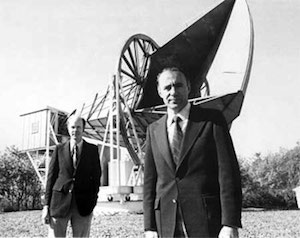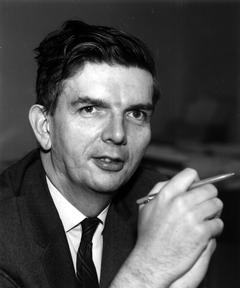Murmur of a Bang

Image credit: Bell Labs
Arno Penzias and Robert Wilson in front of the Holmdel Horn
Astronomers have identified a mysterious and faint cosmic radio signal from the birth of the Universe. The discovery provides the first observational evidence that the universe started with a Big Bang and clues about how it might end.
The faint radio signal comes in the form of microwaves, which lie on the electromagnetic radiation spectrum between radio waves and infrared light. The microwaves come from every direction of space, every hour of every day. The wavelength matches the radiation some scientists predicted would exist if the universe started with a hot explosion of hydrogen about seven billion years ago and steadily cooled since that time. Anything with a temperature greater than absolute zero will give off electromagnetic radiation. If the universe had originally been very hot and condensed, and then expanded and cooled, some of that radiation could still be detectable today.
This discovery of what's being called "cosmic background radiation" was made more or less by accident by Arno Penzias and Robert Wilson of Bell Telephone Laboratories. The two were trying to track down the source of unwanted microwave signals being picked up by a 20-foot horn-antenna in Holmdel, N.J. The "Holmdel horn" antenna was built to test communications with the Echo satellite that NASA put into orbit in 1960 to bounce radio signals back to Earth.
When the Holmdel horn was aimed at zenith (directly overhead), Penzias and Wilson found that the antenna picked up a microwave signal that matched a temperature of 6.7 degrees Kelvin. After subtracting natural microwave radiation from Earth's atmosphere and from the antenna itself, Penzias and Wilson were still left with unexplained microwave radiation that matched a temperature of 3.5 degrees Kelvin coming from empty space. They had no explanation for it, as empty space should be absolutely cold, or zero degrees Kelvin.

Image credit:AIP Emilio Segre Visual Archives, Physics Today Collection
Robert Dicke
Luckily, just down the road at Princeton University, some scientists had the solution. Astronomer Robert Dicke and his team were in the process of building a telescope that could detect this "cosmic background radiation." When they heard about Penzias and Wilson's mystery microwaves at 3.5 degrees Kelvin, they knew it was what they were looking for. After discussing the matter, the Bell Lab and Princeton teams announcedthe discovery in a pair of letters published in the July issue of Astrophysical Journal.
"The presence of thermal radiation remaining from the fire-ball is to be expected if we can trace the expansion of the universe back to a time when the temperature was of the order of [10 billion˚] K," wrote Robert Dicke and his team. This fireball was the very hot, dense ball of matter and energy that existed at the beginning of the universe.
Amazing as the discovery is, to some astronomers it wasn't really a surprise. In the late 1940s, George Gamow, Ralph Alpher and Robert Herman had said there had been a "Big Bang" and that its heat should still be detectable. In 1949 Alpher and Herman reworked some of Gamow's earlier calculations and predicted that this heat (cosmic background radiation) would now have a temperature of "a few degree Kelvin." They were correct.
However, Alpher and Herman incorrectly thought this background radiation could not be detected as it would be drowned out by starlight and other radiation from objects in space. Instead, it appears that the Big Bang has cooled in a way that channels energy into specific wavelengths of radiation. This is what Dicke and his team suspected and one reason they were planning to look for microwave radiation. It's also why they knew Penzias and Wilson's unexplained microwave radiation was actually quite a significant discovery.
Of course, the picture is not rosy for all scientists studying the Universe. While supporting the Big Bang theory, the cosmic background radiation has caused big problems for the Steady State theory of the Universe. That theory, which recently was favored by many astronomers, says that the expansion of the universe is caused by the spontaneous creation of particles in empty space. The Steady State theory does not predict and cannot explain the cosmic background radiation, so its discovery greatly weakens this theory.
Then there are the possible fates of the universe implied by the Big Bang. Either the universe will expand and cool forever as an "open universe," explain Dicke and his team, or it is a "closed universe." In a closed universe the gravity of all the matter in the universe will pull it all back together in another hot ball, breaking down matter and energy again into their basic building blocks. Then it will explode outward again in another big bang to create a totally new universe. This Dicke refers to as an "oscillating universe." Oddly, this resembles the old Steady State model in at least one way: It has no beginning or end. Sadly, however, it also offers no way of detecting what came before the last bang and no escape from being crushed together into another hot ball before the next. •



